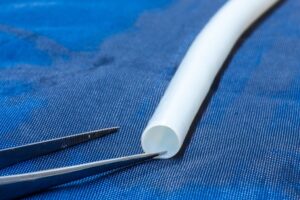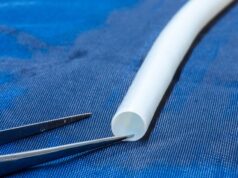
Humacyte today announced the publication of clinical results evaluating the efficacy and safety of the acellular tissue engineered vessel (ATEV) in the repair of extremity civilian and military injuries in JAMA Surgery, an American Medical Association peer-reviewed journal.
The publication describes two clinical studies in which the ATEV demonstrated benefits in terms of patency, limb salvage, and infection resistance compared to synthetic graft benchmarks in the treatment of acute vascular injuries of the extremities.
“The development of a vascular conduit that resists infection and remodels into native arteries is an extraordinary technological advancement that will have a huge impact on the quality of trauma care around the world,” said Charles J Fox (University of Maryland Capital Region, Lake Arbor, USA), a clinical investigator in the Humacyte V005 trauma clinical trial.
He continued: “The ATEV is perfectly sized to treat most injuries, has excellent handling properties, and reduces time necessary to save both life and limbs. Finally, an innovative technology has been developed for battlefield vascular injuries using a tissue engineered human arterial replacement that can resist infections that are so prevalent in modern combat zones. The ATEV shows promise to reduce amputation rates since an alternative conduit for war injuries is often needed but up until now has not been a good option.”
The JAMA Surgery publication described the results of two studies in which the ATEV was evaluated in patients with extremity vascular trauma. The V005 clinical trial was a single-arm study conducted in the USA and Israel in patients with arterial injuries resulting from gun shots, workplace injuries, car accidents, or other traumatic events for whom the standard of care, saphenous vein, was not feasible or available to use as a bypass graft. The V017 single-arm clinical trial evaluated patient outcomes from a humanitarian programme in which patients with wartime injuries were treated in Ukraine.
As single-arm studies, the comparators for the ATEV results were a systematic literature review and meta-analysis of studies conducted with synthetics grafts, providing a current treatment benchmark comparison. In a meta-analysis combining the V005 and V017 trials, the ATEV demonstrated higher patency with a 30-day secondary patency rate of 91.5% for the extremity patients compared to 78.9% historically reported for synthetic grafts. For the secondary comparison of amputation rates, the ATEV demonstrated an improvement with a rate of 4.5% for extremity patients compared to 24.3% historically reported for synthetic grafts. For the secondary comparison of infection, the ATEV demonstrated an improvement with a reduced rate of 0.9% for the extremity patients compared to 8.4% historically reported for synthetic grafts. In summary, researchers concluded that the 30-day outcomes in civilian and military trauma patients indicate superior secondary patency, limb salvage, and resistance to infection of the ATEV conduit compared to synthetic grafts.
“I believe that the ATEV will revolutionise vascular trauma care and be profoundly beneficial to our patients,” said Rishi Kundi (University of Maryland’s R Adams Cowley Shock Trauma Center, Baltimore, USA). “Based on my personal experience so far, the ATEV will allow reconstruction that is currently impracticable because of contamination or infection; moreover, it will make reconstruction that we are now forced to perform with prosthetic or even biologic grafts more successful. I am excited about the promise that the ATEV holds for the long-term experience and outcomes of our patients.”
Also published were longer term follow-up results from the V005 and V017 studies. The ATEV was observed to be mechanically durable and does not appear to dilate or become stenotic over time. Long-term outcomes for secondary patency, limb salvage, freedom from conduit infection, and patient survival were evaluated by Kaplan-Meier analysis. The average follow-up duration for patients receiving the ATEV for extremity trauma is 334.4 days, with a total patient exposure of 61.3 years. These results showcased the potential of the ATEV to retain patency over the longer duration of follow-up. No ATEV infections or patient deaths were reported after month three.
“If approved by the FDA [US Food and Drug Administration], the ATEV will be the preferred conduit for complex extremity vascular injuries, and particularly those at risk for infection,” said Ernest E Moore (Denver Health, Denver, USA), a clinical investigator in the V005 trial. “I look forward to the ATEV being available for use in my practice.”
Evaluation of the safety of the ATEV indicated no safety signals attributable to ATEV mechanical weakness, contamination, or immune rejection. Overall, adverse events (AEs) and serious adverse events (SAEs) were consistent with patients suffering from acute injuries. Adverse events of special interest (AESIs) including thrombosis, rupture, aneurysm, and pseudoaneurysm, occurred at rates that were consistent with reports of other vascular conduits, including autologous vein and synthetic grafts. The meta-analysis combing the V005 and V017 trials showed a 30-day rate of death in ATEV patients of 3.5%, comparable to the 3.4% rate historically reported for synthetic grafts. There were no deaths attributable to the ATEV.
A press release notes that the ATEV is an investigational, first-in-class bioengineered human tissue that is designed to be a universally implantable vascular conduit for use in arterial replacement and repair, and for use as haemodialysis access. While harvesting vein from a trauma patient requires critical surgical time, the ATEV is designed to be available immediately, off the shelf. A Biologics License Application for the ATEV in a vascular trauma indication is currently under review by the FDA.
Humacyte advises that the ATEV is an investigational product and has not been approved for sale by the FDA or any other regulatory agency.











